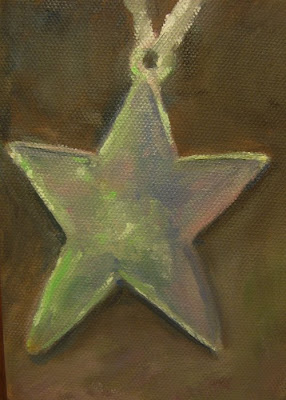
Do you remember those stars you made as a child around Christmas? They were cut from cardboard and carefully covered with aluminum foil then hung from the tree proudly. They were misshapen and wrinkled, but to you they were the best thing you created and you loved them as they caught the light and twinkled.
That's why I bought this pale irridescent glass star. It reminded me of those tinfoil stars made many years ago. The colours change with every movement, going from pinks and lavenders to greens, yellows and blues.
I have learned that painting irridescence isn't easy to do. T.O.O. (the other one) suggested shiny paint, as my frustration with this piece reached the main floor of the house. The suggestion resulted in more frustration.
Then I decided that I need to really understand irridescence. Can irridescence only be recreated using pearlescent paints or man made substances outside of nature?
Dichroic glass is a prime example. Or is it a matter of very detailed dissection of a subject through colour and value changes, not daring to breathe or move while you do so, lest the light and colour move with you?
Wikipedia states:
Iridescence is an optical phenomenon in which hue changes with the angle from which a surface is viewed. Iridescence may be easily seen in soap bubbles and butterfly wings.
Iridescence is caused by multiple reflections from multi-layered, semi-transparent surfaces in which phase shift and interference of the reflections modulates the incident light (by amplifying or attenuating some frequencies more than others). This process is the functional analog of selective wavelength attenuation as seen with the Fabry-Pérot interferometer.
The word iridescence is derived in part from the Greek word iris (pl. irides), meaning "rainbow", which in turn derives from the goddess Iris of Greek mythology, who is the personification of the rainbow and acted as a messenger of the gods. Goniochromism is derived from the Greek words gonia, which means angle, and chroma, which means color.
Erin Parish is one artist that I've discovered whose work gives that wonderful feeling of irridescence. She does use multimedia though and I wonder if that is the trick to making irridescence more believeable than in just paint.
I did find some information on
interference pigments that may unlock some secrets to painting irridescence. I know the illusion of irridescence can be achieved on some scale in water, shells, etc through paint. This glass star doesn't present the lustre that I'm looking for. External influences in terms of lighting, movement, background surface and my skill level and reproducing it all come into play. I will keep looking for that lustre.







